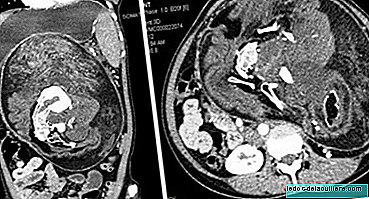
It has been shown that Fluoride is effective for caries prevention, but if we swallow too much fluoride during the period of tooth formation (in toothpaste or mouthwashes that contain it), the enamel of the teeth can be altered and stains appear, which is known as "fluorosis."
Thus, the use of fluoride in young children has some recommendations within safety limits. The Spanish Association of Pediatrics recommends up to six years to use a children's toothpaste, specific for children, since they contain fluoride, but less. Although this is not the only recommendation. What about the youngest children?
Up to two years you have to put only a small amount of this children's toothpaste (with fluoride), like a graffiti on the brush, and between two and six years in quantity like a pea. From the age of six they can already use the paste of adults and the amount of one to two centimeters on the brush. We will return to these recommendations below.
Parents should supervise the toothbrushing process until at least seven years of age (to avoid swallowing paste) and it is important that children brush their teeth at least twice a day and especially important is brushing the night before bedtime.
In the latest protocols for the use of fluoride in children (Consensus document of the European Academy of Pediatric Dentistry) with the Spanish Society of Pediatric Dentistry "vehemently" recommends that daily use of fluoride should be the main part of any complete prevention program for caries control in children.
He adds that the use of fluoride should be balanced between the estimation of caries risk and the possible risks of the toxic effects of fluorides.
The Spanish Society of Pediatric Dentistry notes that toothbrushing with fluoride paste is the closest to the ideal method of public health, since its use is practical, cheap, culturally approved and powerful. But remember the significant risk of children swallowing considerable amounts of fluoridated pastes, especially in the first three years of life.
In fact, it has been calculated that a preschool, with two daily brushings, can swallow about 1 gram of toothpaste per day, due to the immaturity of the swallowing reflex. That is why you have to control the little ones well when they brush their teeth.
So, fluoride paste, yes. Regarding fluoride concentration, there is not enough evidence that a toothpaste with a fluorine concentration of 500ppm or less has a preventive effect against tooth decay, so we should look for a paste with a higher concentration.

Risk of stains on tooth enamel and recommended fluoride
Fluorine is a chemical element belonging to the group of halogens, which in humans is mainly associated with calcified tissues (bones and teeth) due to its high affinity for calcium. When consumed in optimal amounts, dental mineralization and bone density can be increased, the risk and prevalence of tooth decay can be reduced, and enamel remineralization can be helped at all times of life. But how much fluoride is adequate?
The studies that have summarized the risks of suffering from enamel spots or fluorosis they conclude that the risk is greater when the exposure takes place in the secretory phases, as in the maturation of enamel formation. There are therefore differences between the ages:
Zero to four years. Calcification and maturation of the first permanent incisors and molars occurs, so young children are at risk of presenting spots on these pieces. More specifically, It is between 15 and 30 months of age the period of greatest risk. Here the one that the use of fluorides must be carefully controlled and balanced with the needs to prevent the appearance of caries in childhood. Special attention should be given to the use of fluorides of topical application (toothpaste) during this period of life due to inadequate control by the child of the swallowing reflex: paste or mouthwash is swallowed. Between six months and two years, the European Academy of Pediatric Dentistry recommends brushing twice a day with a toothpaste with 500ppm of fluoride and the amount similar to a pea. After two years a paste with 1000 ppm can already be used. of fluoride
Four to six years. Calcification and maturation of the posterior teeth (premolars and second molars) occur and there is a high risk of enamel stains forming, although in this case it represents a minor aesthetic problem (these pieces are not usually seen) and need to be opposed against to the marked benefit in the prevention of caries that involves the use of fluorides. Between two and six years, brushing has to be twice a day with a toothpaste with between 1,000 and 1,450 ppm of fluoride and the amount remains similar to a pea.
Six years and older. The risk of enamel stains forming during this period is negligible, with the exception of third molars, which have not yet emerged. Brushing twice a day with a toothpaste with 1,450ppm of fluoride and the amount of one to two centimeters is advised.
What about mouthwashes?
Today there are a considerable amount of "home use" mouthwashes specifically for children on the market. In case you use them, it will be these rinses or mouthwashes and not others who use our children, since those of adults contain more fluoride and have more risks of fluorosis.
These rinses for home use are effective in preventing tooth decay, so their use is recommended to prevent tooth decay in permanent teeth. There is no evidence in temporary teeth, so it is not recommended for use in children under six years. This is stated by the Spanish Association of Pediatrics:
Diluted solutions of fluorine salts are used with which daily or weekly mouthwashes are performed. They should be recommended after six years to ensure that the child will not drink the liquid.
In any case, it is recommended:
- Supervision of the procedure by the parents or other responsible adult.
- For daily use, a 0.05% fluoride solution can be used.
- Children should rinse 10 milliliters of mouthwash for a minute to spit out the mouthwash later, avoiding ingestion.
- The child should be instructed not to eat, drink or rinse his mouth with anything for half an hour after rinsing the fluoride mouthwash, because intake of this element would occur.
- As an alternative, a weekly rinse with a concentration of 0.2% can be performed, without ingesting in the next half hour.
In conclusion, we note that toothpastes used by children must be specific for children, since they contain fluoride in the appropriate amounts to effectively prevent tooth decay and reduce the risks of fluorosis. And always accompany him in brushing!












